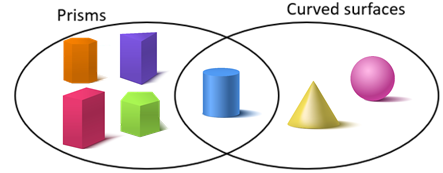The purpose of this activity is to support students using their understanding of properties to establish differences and similarities between, and among, three-dimensional shapes. Similarity is the basis of classifying shapes by their defined properties and difference is important in recognising non-examples.
- Copymaster (odd shape out cards)
- Set of three-dimensional shapes
- Show the students Set A from the Copymaster, either on paper or a shared screen.
One of these shapes is the odd one out. It is different from the other two.
Which shape is the odd one out?
- Let students select a shape and describe or record their reason for selecting it.
- Together, discuss the possible odd shape out. Each shape can be chosen, depending on the criterion used. As students explain their choice, ask them to point to the shape and the property they are referring to. Use their explanations about faces, edges, vertices, and curved surfaces as an opportunity to reinforce important vocabulary, and if appropriate to your learners' knowledge, relevant te reo Māori kupu (e.g. tapa - side/edge, akitu - vertex, mata - face). Justifications might include:
- Cone: Has a curved surface while the others only have faces.
- Square based pyramid: Only shape with triangular faces. Only shape with 5 vertices and 8 edges.
- Cube: Only shape that does not have an apex. Only shape with equal faces (squares)
- Pose other suggestions for choosing the odd shape out.
- [Name] says that only the cone has a single circular face. Is he/she correct?
Note that the base of the cone can be regarded as a face, since it is flat and encloses the cone. - [Name] says that only the cube has parallel faces. Is he/she correct?
Opposite faces of the cube are parallel so there are 3 pairs of parallel faces. The other shapes have no parallel faces. - [Name] says that only the cube has three faces meeting at each vertex. Is he/she correct?
Around each vertex of the cube are three faces. The square-based pyramid has three faces meeting at each vertex on the base, so the person is wrong. Note the apex has four faces meeting.
- [Name] says that only the cone has a single circular face. Is he/she correct?
- Repeat the challenge with Set B.
Ask students to work in pairs. Consider organising these pairs to encourage tuakana-teina (reciprocal learning).
This time I want you to find a reason for each shape. How can each shape be the odd one out?
- After a suitable time discuss students’ ideas.
Are all the shapes similar in some way? Students might say that all three shapes roll because they all have a curved surface. Some make connect to the presence of circles in all three shapes.
Justifications might include:- Cylinder: Two parallel faces so the only prism-like shape,
- Sphere: No faces just a single curved surface, circular cross-section.
- Cone: An apex so the only pyramid-like shape, one circular face.
- Continue using the four other sets of shapes from the Copymaster as further practise at identifying similarities and differences, either for pairs of students or for the whole group.
Next steps
- Ask students to create their own set of three shapes for an “odd shape out” set. They should provide answers for how each shape can be the odd one out, before trialling their set to see if the ideas of others are the same as their ideas.
- Explore the concept of intersection with a set of three-dimensional shapes. Use the metaphor of an intersection of two streets. The example below shows the intersection of a set of prisms and a set of shapes with curved surfaces.

In a Venn diagram, the relationships are shown as follows: